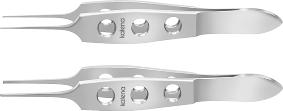Forceps
| (Many different designs of forceps
are available in ophthalmic surgery. Only the most commonly used are described
here. Some of the forceps have been described elsewhere but for completeness
are included here.) |
|

Moorfields forcep. This has been described under instruments
for strabismus operation. The grooves at the tip allow easy grasping of
the slippery conjunctiva. |
|
 ... ...
Utrata forceps |
Utrata forcep with magnified tips.
The forceps have sharp tips which are perpendicular to
the body. They are designed specially for tearing the capsule or completing
the capsulorrhexis during cataract extraction. |
|
 |
Adson forcep.
This forcep is designed for grasping skin during oculoplastic
surgery. The tips have teeth set at right angle to each other. |
|
 .................. .................. |
Colibri forcep.
Colibri means bird in Italian and refers to the original
design of the forceps. The forcep is designed to perform several functions.
The tooth at the tip is ideal for holding the corneal
or scleral edge when passing a suture. It can also be used for gasping
iris tissue. In addition, there is a flat platform behind the tips which
allows for suture-tying. The long and thin body also means that the surgical
view is not obstructed during the surgery. |
|
 .......... .......... |
Bishop-Hammon's forceps.
The teeth at the tips are at right angle to the body.
It is used for gasping tissue. |
|
 .......... .......... |
Castroviejo forceps.
The teeth are forward-angled for easy grasping and manipulation
of tissues. |
|
 ....... ....... |
Pierse forceps.
The tips have opposing flat surface
and causes less trauma. However, the grasp may be less stable than other
tooth forceps. |
|
 ... ... . .
Stright Mcpherson forcep
. .... ....
Angled Mcpherson forcep |
Mcpherson forcep.
These forcep may be angle or straight. The tip has a
flat platform designed for tying fine suture. It is commonly used in corneal
graft and during extract capsular cataract extraction . It should
not be used for holding tissues as it can crash them. |
|
|
|